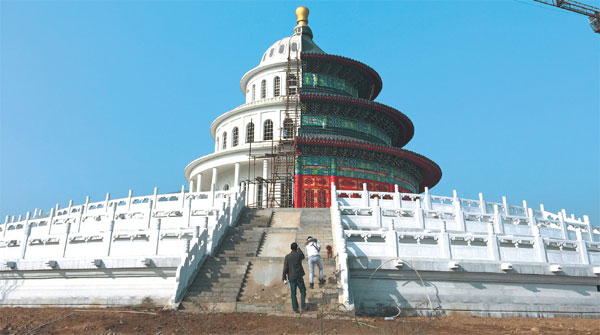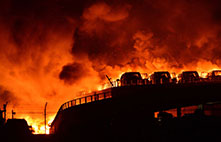A Shijiazhuang film studio of split personalities
Updated: 2016-01-04 14:13
By Zhang Yu and Wang Wei(China Daily)
|
||||||||
Eye-catching structure is fusion of traditional Chinese palace and US' Capitol Hill, as Zhang Yu and Wang Wei report in Shijiazhuang.
A quirky and uniquely designed building, one side of which looks like a traditional Chinese palace while the other resembles the United States' Capitol Hill, is catching a lot of attention and praise in Hebei province.
Located at the New Great Wall International Studio in Shijiazhuang, near the village of Donggoucun in the provincial capital of Shijiazhuang, the eye-catching structure is partly modeled after the Hall of Prayer for Good Harvests (Qinian Dian) of the Temple of Heaven in Beijing.

Lyu Yafeng, a resident of Shijiazhuang, is one such curious passer-by.
"I couldn't wait to check it out in person," said Lyu, who read about it in a news report. "Just imagine you're looking at Qinian Dian, wouldn't you be surprised if you find that the other side of the building looks like the US Capitol?"
He said that after he posted a picture of the building on a social media app, he received a lot of comments from friends who were just as curious.
One of the comments came from Lyu's friend Lei Jing, who works in Switzerland but is from Shijiazhuang. Lei commented that the building must be "a patchwork of two photos edited with graphic tools" and that she couldn't believe it was a real building in her hometown.
"Don't doubt it, it's real and what you see is the face without makeup," Lyu replied on the app.
Next to the unique structure is a near-exact replica of Egypt's Great Sphinx of Giza. Su said the replica measures 87 meters long and 27 meters tall, similar to the measurements of the Great Sphinx.
After Lyu posted a picture of the replica, a friend asked, "Are you in Egypt?" to which Lyu replied, "I am actually in China."
"Technically, it's not an exact copy of the Great Sphinx because the interior follows ancient Chinese architectural styles," he said. But "what an amazing architectural work. It's so creative and interesting. How can you imagine there's an ancient Chinese imperial palace inside the body of a sphinx."
Su said the imperial palace interior is used for TV series, while the exterior is mainly for tourism purposes.
The base also has many other replicas of famous structures from China and abroad, such as a glass replica of The Louvre in Paris and buildings modeled after the Fujian Tulou, the inward-looking circular housing in Fujian province.
In recent years, replicas of famous buildings have emerged across the country either as film and TV production sets or for tourism purposes.
Fang Xiangshuo, an architect at the Suzhou Institute of Architectural Design Co, said imitating famous structures from China and around the world is not difficult in design or construction.
"It's not like creating original structures from scratch, which needs inspiration and sophisticated calculation," said Fang, who added that replicas can be built in a shorter amount of time with modern advanced technologies.
And the building materials and the workmanship for the replicas are likely to be different from the old structures, Fang said.
"They just need to bear a resemblance to the appearance of the original structures for the aim of making films and TV series, and satisfying the curiosity of casual tourists who haven't seen the originals," Fang said.
A worker surnamed Liu at the Hebei Provincial Administration of Cultural Heritage said people should not think the replicas are the same as the originals.
"For film and entertainment purposes, it's OK. But there's no cultural value or history embedded in the replicas," Liu said.
In other parts of China, there are miniatures of famous architectural wonders.
Jing Xiaofeng, who lives in Shenzhen, Guangdong province, said the city has a park named the "Windows of the World" that features miniatures of famous scenic spots and historical relics such as towers and museums from different countries.
"The park represents a living history of China and the world through its use of replicas of ancient palaces and streets," Jing said. "People can come to understand more about these famous structures and feel like they have traveled through time and space."
Wang Zhe, a tourist who once toured a similar park in Changsha, Hunan province, said the miniatures are much too small.
"What's the point of making such grotesque and fake replicas? They are so unnatural," Wang said.
Contact the writers at zhangyu1@chinadaily.com.cn
Production studios spring up across China
The New Great Wall International Studio is both a production base for films, TV series, animations and games and a tourism hot spot.
The base, which is under further construction, has produced six TV series and is open to the public, said Su Yaran, a spokesperson for the base.
It will expand to 206.67 hectares next year and has a total investment of 5 billion yuan ($774 million). The company, of the same name as the studio, also has a similar park in Chuzhou, Anhui province, and plans to construct four other parks across the nation.
Since 1987, when China's first large-scale movie and TV shooting base was built, production bases and parks for TV and film have emerged around the country. There are now thousands of the bases nationwide, according to a People's Daily report.
"That's because China is making more and more films and TV series," said a film director surnamed Yang from Tianjin.
According to the State Administration of Press, Publication, Radio, Film and Television, China produces the world's highest number of TV series, with 429 TV series and 15,983 episodes last year. That is an average of about 44 episodes made every day throughout the year. Each episode usually lasts 45 minutes.
(China Daily USA 01/04/2016 page6)
- Top planner targets 40% cut in PM2.5 for Beijing-Tianjin-Hebei cluster
- Yearender: Predictions for 2016 through 20 questions
- Asia's largest underground railway station opens in Shenzhen
- Shanghai bans drug-using actors, drivers
- Clamping down to clean up the air
- Yearender: Ten most talked-about newsmakers in 2015
- Over 1 million refugees have fled to Europe by sea in 2015: UN
- Turbulence injures multiple Air Canada passengers, diverts flight
- NASA releases stunning images of our planet from space station
- US-led air strikes kill IS leaders linked to Paris attacks
- DPRK senior party official Kim Yang Gon killed in car accident
- Former Israeli PM Olmert's jail term cut, cleared of main charge

 127th Tournament of Rose Parade celebrated to embrace 2016
127th Tournament of Rose Parade celebrated to embrace 2016
 Yearender: China's proposals on world's biggest issues
Yearender: China's proposals on world's biggest issues
 NASA reveals entire alphabet but F in satellite images
NASA reveals entire alphabet but F in satellite images
 Yearender: Five major sporting rivalries during 2015
Yearender: Five major sporting rivalries during 2015
 China counts down to the New Year
China counts down to the New Year
 Asia's largest underground railway station opens in Shenzhen
Asia's largest underground railway station opens in Shenzhen
 Yearender: Predictions for 2016 through 20 questions
Yearender: Predictions for 2016 through 20 questions
 World's first high-speed train line circling an island opens in Hainan
World's first high-speed train line circling an island opens in Hainan
Most Viewed
Editor's Picks

|

|

|

|

|

|
Today's Top News
Shooting rampage at US social services agency leaves 14 dead
Chinese bargain hunters are changing the retail game
Chinese president arrives in Turkey for G20 summit
Islamic State claims responsibility for Paris attacks
Obama, Netanyahu at White House seek to mend US-Israel ties
China, not Canada, is top US trade partner
Tu first Chinese to win Nobel Prize in Medicine
Huntsman says Sino-US relationship needs common goals
US Weekly

|

|








